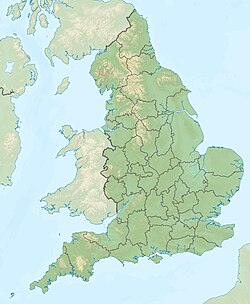Beacon Limestone Formation
Geological formation in England From Wikipedia, the free encyclopedia
The Beacon Limestone Formation, historically known as the Junction Bed, is a formation of the early Jurassic age (Pliensbachian–Toarcian). It lies above the Dyrham Formation and below the Bridport Sand Formation. It forms part of the Lias Group. It is found within the Wessex Basin and parts of Somerset,[1] in England. It is well known for the Strawberry Bank Lagerstätte, which contains the 3-dimensionally preserved remains of vertebrates, including marine crocodyliformes, ichthyosaurs and fish, as well as insect compression fossils.[2]
| Beacon Limestone Formation | |
|---|---|
| Stratigraphic range: Upper Pliensbachian–Toarcian Spinatum-lowermost Thouarsense ~ | |
Cliff exposure at Thorncombe Beacon | |
| Type | Geological formation |
| Unit of | Lias Group |
| Sub-units | Marlstone Rock, Barrington & Eype Mouth Limestone Members |
| Underlies | Bridport Sand Formation |
| Overlies | Dyrham Formation |
| Thickness | Up to 5 metres (16 ft) Averaging <1.5 metres (4.9 ft) |
| Lithology | |
| Primary | Limestone |
| Location | |
| Coordinates | 50.9°N 2.8°W |
| Approximate paleocoordinates | 38.4°N 7.4°E |
| Region | Somerset, Dorset |
| Country | England |
| Extent | Wessex Basin |
| Type section | |
| Named for | Thorncombe Beacon |
| Location | Cliff exposure beneath Thorncombe Beacon |
Fossil content
Summarize
Perspective
Among others, the following fossils have been reported from the formation:
Vertebrates
| Vertebrates of the Beacon Limestone | ||||||
|---|---|---|---|---|---|---|
| Genus | Species | Location | Stratigraphic position | Abundance | Notes | Images |
| Hauffiopteryx | H. typicus | Strawberry Bank | Falciferum zone | Lectotype: GPIT 1491/4, referred: BRLSI M1399, BRLSI M1400,
BRLSI M1401, BRLSI M1403, BRLSI M1404 and BRLSI M1406[3] partial skeletons |
Ichthyosaur subsequently suggested to belong to Leptonectes[4] | |
| Stenopterygius | S. triscissus | Holotype: GPIT 12/0224-2 referred: BRLSI M1405, BRLSI M1407, BRLSI M1408 and BRLSI M1409[3] partial skeletons | Ichthyosaur | |||
| Pelagosaurus | P. typus | "four isolated skulls and associated postcranial skeletal elements along with two articulated specimens, one of which is a small juvenile"[5] | Thalattosuchian | |||
| Pachycormus | P. macropterus | BRLSI M1297, BRLSI M1299, BRLSI M1320, BRLSI M1332, BRLSI M1359, BRLSI M1389, BRLSI M1395, BRLSI M1341, BRLSI M1351, BRLSI M1366, BRLSI M1393[6] | Pachycormiform fish |  | ||
| Leptolepis | Indeterminate | BRLSI M1259 complete specimen.[2] | 4–8 cm (1.6–3.1 in) in length | GB3D | ||
| Lepidotes | Indeterminate | 40–45 cm (16–18 in) in length | ||||
| Caturus | Indeterminate | "two specimens, including an isolated neurocranium (BRLSI M1288)"[2] | Amiiform fish | BRLSI | ||
Invertebrates
| Invertebrates of the Beacon Limestone | ||||||
|---|---|---|---|---|---|---|
| Genus | Species | Location | Stratigraphic position | Abundance | Notes | Images |
| Trivenapteron[7] | T. moorei | Strawberry Bank | Falciferum zone | Dermapterid earwig | ||
| Fulgoridulum | Indeterminate | Fulgoridiid planthopper | ||||
| Necrotaulius[8] | N. parvulus | Necrotauliid Trichopteran | ||||
| Liassogomphidae | Indeterminate | Odonata | ||||
| Elcanidae | Orthoptera | |||||
| Archegocimicidae | Hemiptera | |||||
References
Wikiwand - on
Seamless Wikipedia browsing. On steroids.

